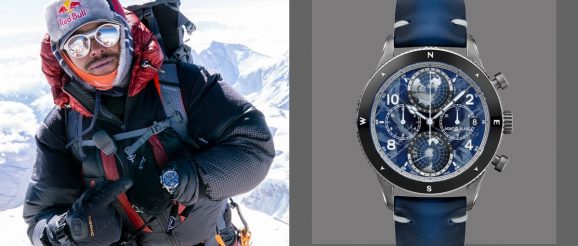Montblanc’s Everest-Summiting New Watch Is Part of a Long Tradition of Innovation

Welcome to Dialed In, Esquire’s weekly column bringing you horological happenings and the most essential news from the watch world since March 2020.
We begin this week’s installment of Dialed In with a marriage of engineering and aesthetics that dates back almost 120 years. But it’s not a watch. It’s a pen. Bear with us, and it will all make sense.
Montblanc was founded back in 1906 (under another name) in the north German port of Hamburg. Its invention was the Simplo fountain pen, a pen that ran on its own internal supply of ink. This was not at all a new idea; in fact, the first patent for a fountain pen was issued as far back as 1702 in Paris. But for more than 200 years, such would-be inventions were plagued by leaks, blockages, and general unreliability. Montblanc, taking advantage of the refined engineering capabilities of the new century, did much to develop viable and easy-to-use pens. It required immense precision to make pens flow with a consistent supply of ink without covering the user’s hands with it. By the ’30s, the company was known in 60 countries, not least for the iconic Meisterstück pen that it introduced in 1924.
Progress eventually intervened to endanger the fountain pen—first, the invention of the ballpoint and, ultimately, the computer age. Slowly, however, instead of disappearing, the fountain pen—especially at Montblanc—has evolved into a thing of luxury, less a daily tool and more an expression of analog joy. Much, you might say, like the mechanical wristwatch, which the brand began to create in 1997.
Last month Montblanc opened up a new purpose-built space at its HQ in the suburbs of Hamburg to celebrate the history of the brand. It is filled with products from the Montblanc early years—especially those famous pens—and also much of the advertising imagery that made it a broad success, including, in the 1920s, planes painted all over with Montblanc branding or delivery vans with giant pens mounted on the roof. But don’t call it a museum. The Montblanc Haus was conceived by CEO Nicolas Baretzki with his creative team, and designed and built by architecture firm Nieto Sobejanos, based in Berlin and Madrid. The space, spread over 3000 square meters, is instead devoted to the art of writing, a phrase the brand has done much to own since it first started using it in the late 1930s. There are, of course, a lot of pens including many of the elevated limited editions inspired by writers and creative thinkers that Montblanc has produced over the past 30 years. There are also handwritten (fountain pen, natch) letters by the likes of Hemingway and Einstein on display, part of a growing collection. There’s also a space for visitors to record their thoughts—or doodles—in a digital guest book. For Montblanc, the Haus is the opposite of a museum, and more a celebration of the human impulse to create and communicate.
At the same time, Monblanc’s efforts in high watchmaking continue to inspire and delight. Last month too, its new ambassador, Nepal-born British climber Nimsdai Purja scaled three peaks in the Himalayas (Everest, Lhotse, and Kanchenjunga) without the aid of supplemental oxygen, in a record breaking eight days and 23 hours. He did it wearing a new limited edition Montblanc watch, the 1858 Geosphere Chronograph “0 Oxygen.” This watch, something of a first for the brand, was assembled in a vacuum and sealed with no air inside it. Far from being a gimmick, the absence of air inside the watch is a long-term protector of the movement from corrosion and condensation, proof that Monblanc’s original founding ethos of fusing technology, functionality, and beauty is as much a thing of the future as it is of the past.
